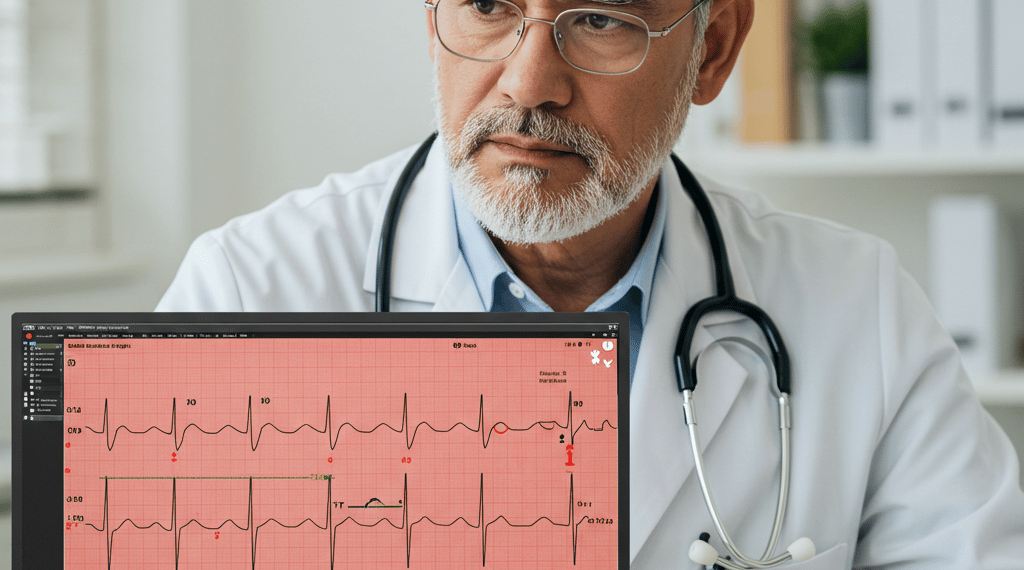The Science Behind Automated ECG Interpretation
Electrocardiography (ECG) is a fundamental diagnostic tool in cardiology, used to assess cardiac rhythm, detect ischemic changes, and identify structural abnormalities of the heart. Traditionally, ECG interpretation has relied on human expertise, but advances in artificial intelligence (AI) and pattern recognition software have revolutionized this process. Automated ECG interpretation systems leverage machine learning algorithms and signal processing techniques to analyze ECG waveforms, aiding in the rapid and accurate diagnosis of various cardiac conditions. This document delves into the science behind automated ECG interpretation, its applications, the available solutions in the market, and key considerations for decision-makers and procurement agencies
3/24/20253 min read


Signal Processing in ECG Analysis
Automated ECG interpretation begins with the acquisition of electrical signals from the heart using electrodes placed on the skin. These signals are processed through several key steps:
Preprocessing: Raw ECG signals are filtered to remove noise from muscle activity (electromyographic noise), power line interference, and baseline wander. Techniques such as wavelet transforms and adaptive filtering are commonly used (Martis et al., 2013).
Feature Extraction: The software identifies key ECG features such as P waves, QRS complexes, and T waves. Methods like discrete wavelet transform (DWT) and principal component analysis (PCA) are frequently employed (Hammad et al., 2020).
Pattern Recognition and Classification: AI models, particularly deep learning networks, classify the ECG waveform into different arrhythmias or normal patterns. Convolutional neural networks (CNNs) and recurrent neural networks (RNNs) are often used to analyze temporal patterns in ECG signals (Hannun et al., 2019).
Machine Learning and AI in ECG Interpretation
Machine learning algorithms have significantly enhanced ECG analysis capabilities. Some commonly used AI approaches include:
Supervised Learning: Labeled ECG datasets are used to train models to recognize patterns corresponding to specific cardiac conditions such as atrial fibrillation or myocardial infarction (Shen et al., 2019).
Unsupervised Learning: Clustering algorithms identify novel patterns in ECG data without predefined labels, useful for discovering new subtypes of cardiac conditions (Zihlmann et al., 2017).
Deep Learning Models: CNNs are highly effective in spatial feature extraction, while long short-term memory (LSTM) networks and transformer models capture temporal dependencies in ECG signals (Attia et al., 2019).
Validation and Accuracy of AI-based ECG Systems
Automated ECG interpretation systems are validated using large datasets from clinical studies. Performance is typically measured using sensitivity, specificity, and F1 scores. High-quality datasets such as PhysioNet’s MIT-BIH Arrhythmia Database and the Stanford Arrhythmia Database are commonly used for training and testing models (Goldberger et al., 2000).
Applications of Automated ECG Interpretation
Clinical Decision Support
AI-powered ECG systems provide rapid preliminary interpretations, allowing clinicians to focus on critical cases. This is particularly useful in emergency settings where immediate triage is necessary.
Remote and Wearable ECG Monitoring
Wearable ECG devices, such as the Apple Watch and KardiaMobile, integrate AI to provide continuous heart rhythm monitoring, enabling early detection of conditions like atrial fibrillation (Perez et al., 2019).
Population Screening and Telemedicine
Automated ECG analysis is valuable for large-scale cardiac screening programs, particularly in resource-limited settings. AI-assisted ECG platforms facilitate remote diagnosis, bridging the gap between patients and cardiologists.
Available Automated ECG Interpretation Solutions
Several commercial and open-source ECG interpretation systems are available:
GE Healthcare’s MUSE ECG System: Uses AI for automated interpretation and integrates with hospital information systems.
Philips IntelliSpace ECG: Provides advanced analytics and cloud-based access for remote consultations.
AliveCor Kardia AI: A consumer-grade AI-powered ECG interpretation tool for personal heart monitoring.
MIT-BIH Arrhythmia Classifier: An open-source AI model for arrhythmia classification, widely used in research settings.
Procurement Considerations for Decision Makers
When selecting an automated ECG interpretation system, key factors to consider include:
1. Accuracy and Clinical Validation
Ensure that the AI model has been validated on diverse datasets and demonstrates high sensitivity and specificity.
2. Regulatory Compliance
Check for approvals from regulatory bodies such as the FDA, CE, and Health Canada to ensure clinical safety and efficacy.
3. Integration with Existing Systems
The software should be compatible with existing electronic health records (EHR) and hospital information systems to facilitate seamless workflow integration.
4. Data Privacy and Security
Ensure compliance with HIPAA and GDPR regulations to protect patient data confidentiality.
5. Cost and Scalability
Evaluate the total cost of ownership, including licensing, training, and maintenance. Scalable solutions that support cloud-based access and remote monitoring should be preferred.
6. User Training and Support
Healthcare professionals should receive adequate training on the AI system to ensure optimal utilization and accurate interpretation of results.
Conclusion
Automated ECG interpretation powered by AI and pattern recognition is transforming cardiac diagnostics, improving efficiency, and expanding access to healthcare. The integration of advanced machine learning techniques has significantly enhanced the accuracy and reliability of ECG analysis. Decision-makers must consider factors such as clinical validation, regulatory compliance, system integration, and cost-effectiveness when procuring such systems. As AI continues to evolve, the future of ECG interpretation will likely see further improvements in accuracy, personalization, and real-time monitoring capabilities.
References
Attia, Z. I., et al. (2019). "An artificial intelligence-enabled ECG algorithm for the identification of patients with atrial fibrillation during sinus rhythm: a retrospective analysis of outcome prediction." The Lancet, 394(10201), 861-867.
Goldberger, A. L., et al. (2000). "PhysioBank, PhysioToolkit, and PhysioNet: Components of a new research resource for complex physiologic signals." Circulation, 101(23), e215-e220.
Hannun, A. Y., et al. (2019). "Cardiologist-level arrhythmia detection and classification in ambulatory electrocardiograms using a deep neural network." Nature Medicine, 25(1), 65-69.
Martis, R. J., et al. (2013). "Application of wavelet techniques and PCA for ECG signal classification." Biomedical Signal Processing and Control, 8(5), 437-448.
Perez, M. V., et al. (2019). "Large-scale assessment of a smartwatch to identify atrial fibrillation." New England Journal of Medicine, 381(20), 1909-1917.
Shen, C., et al. (2019). "Deep learning in electrocardiogram diagnosis: A review." Frontiers in Physiology, 10, 1595.
Zihlmann, M., et al. (2017). "Convolutional recurrent neural networks for electrocardiogram classification." Computing in Cardiology, 44, 1-4.
